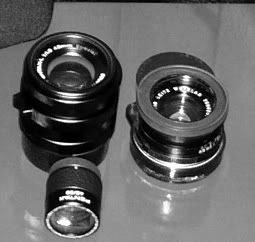squirrel$$$bandit
Veteran
I recently started shooting on film with the Pentax 43mm Limited, an SLR lens that I'd bought to use with a digital camera, and I'm surprised to find how much it reminds me of the Contax G-system 45mm Planar, especially in the bokeh and the way it transitions in and out of highlights. Does anyone know if these lenses are using a similar formula? Here are a couple of wide-open shots...both on Arista Pro 400...the 43 is of my friend and his daughter, the 45 is of my son.


furcafe
Veteran
I have both lenses, though my 43/1.9 is the Leica thread mount version. I haven't noticed any similarity because I haven't shot both @ the same time, but I'm not entirely surprised given the similarity in focal length & in Pentax's SMC & Zeiss's T* coatings (they have common origins in the brief period when the 2 companies were working together in the early '70s, the K-mount is another legacy). I have no idea what type of design was used for the 43/1.9, but I also wouldn't be surprised if it's a double-gauss like the Planar.
squirrel$$$bandit
Veteran
OK, here's the Planar:

And here's the Limited

Can the lens gurus tell me what that extra element is doing?

And here's the Limited

Can the lens gurus tell me what that extra element is doing?
raid
Dad Photographer
I find the Pentax limited edition lens overvalued as a Summicron-C 40mm/2 is just about as good and at a lower cost. I compared the two lenses. Both are excellent.
furcafe
Veteran
Perhaps, but the Minolta 40/2 M-Rokkor is an even better value than the Summicron, & has a normal filter thread to boot.
I find the Pentax limited edition lens overvalued as a Summicron-C 40mm/2 is just about as good and at a lower cost. I compared the two lenses. Both are excellent.
antiquark
Derek Ross
OK, here's the Planar:

And here's the Limited

Can the lens gurus tell me what that extra element is doing?
I don't know, but you might be interested in the Zeiss lens datasheets:
http://www.zeiss.de/c12567a8003b58b9/Contents-Frame/5ed01eb620d0b1cec12570f80033cada
The Planar 50/1.7 has the same layout as the Pentax lens. Take a look at the MTF diagrams, the 50/1.7 and 45/2.0 are quite different in that respect.
raid
Dad Photographer
Perhaps, but the Minolta 40/2 M-Rokkor is an even better value than the Summicron, & has a normal filter thread to boot.
I mentioned the Summicron-C because this is the type of lens that I happen to own and it is the lens that I used to compare the Pentax lens with.
I find the 45mm Planar for the G1 to be a better lens than the Summicron-C or the Pentax.
ferider
Veteran
Can the lens gurus tell me what that extra element is doing?
Not that I'm a Guru, but this looks like a typical 7 element extension of the basic 6 element double Gauss/Planar design, similar to what has been done for the Planar 50/1.7 or 35 Summicron (when moving from v3 to v4). Here is a related instructive post from the Rollei List:
Richard Knoppow said:The basic six element lens works well at f/2.0 but there are problems with the correction of marginal rays for faster lenses. One way of reducing the effect of these rays is to split one or more the the elements of a lens. The idea is the reduce the maximum angle of incidence of the rays of light with the surfaces of the lens elements. If the bending of the light can be split into stages the angle of the light rays is reduced and the intoduced aberrations reduced with the angle.
A 7 element design might have better bokeh and less vignetting, while a 6 element design might flare less, is my personal take. I hate flare and like the 6 element designs
Also consider that Zeiss might have used different glass than Pentax.
Cheers,
Roland.
Last edited:
squirrel$$$bandit
Veteran
Well, both lenses are superb. The Planar is a bit sharper, I think. I love the SLR version of the Limited, but have never used the LTM version, which is larger and costs twice as much used as the K-mount one does brand new...
awilder
Alan Wilder
The 7 element version is a Xenotar variant of the double Gauss design family, something very similar to the modern 6/4 50mm f/2 designs from Zeiss and Leica. The extra element was typically used to improve correction (flatten field?) in the faster designs like f/1.8, f/1.7, f/1.4, f/1.2 and even f/1 designs but as the speed increases performance tend to drop especially with optics faster than f/1.4. Leica has solved the problem recently with a totally reworked design in their 50/0.95 using aspherics and exotic glass. The bottom line is that the 43/1.9 is one of the best reported optics in it's class no doubt in part to the extra element, expensnsive glass and SMC coatings. To me the benefit of the lens is the unique focal length but it's rather large compared to others in that class.
Last edited:
ferider
Veteran
If you like the Pentax and 43mm, you might want to try the 40/1.4 Nokton (IMO 43mm long as well - definitely a bit longer than 40mm Summicron and Rokkor)

Cheers,
Roland.

Cheers,
Roland.
We are in the context of RF lenses, yet the Pentax Limited was designed for SLR use where the distance from the focal plane is greater. Mabelsound's diagrams show the classic RF-type Planar 6/4 symmetrical layout with two cemented pairs.
Picking up on antiquark's comment, Zeiss Planars made for SLR usage separate the front cemented pair in the same way seen in the Pentax diagram. This is also a typical Pentax normal-lens layout (through 85mm), with the total number of elements increasing with the faster lenses, so this 43mm fits with Pentax practice... and Zeiss too.
The 43mm f/1.9 SMC Pentax FA Limited, designed for SLR usage (where room for mirror clearances is needed), was later pressed into service in a different focusing mount for RF usage, the 43mm f/1.9 SMC Pentax-L Special. If you look into the back of this RF lens you'll note the glass is positioned well forward, unnecessarily for RF bodies.
Not being a lens expert, still I'm lead to speculate that the difference in the Planar layouts of elements #2-#3 between RF and SLR lenses reflects the need for the SLR glass to be forward enough to clear the mirror.
And as Roland pointed out, element layout is not the only issue, as there's different glass formulation too. But I expect there would be some resemblance or "family" similarities in the results anyway. As it happens I have both the 43mm varieties, the 45 Planar G, 50 Planar ZM, 50 Planar ZK, and a few Pentax 50's, without having made direct comparisons. Even the Voigtlander 58mm f/1.4 Nokton SL II uses the same SLR-type Planar formula.
Picking up on antiquark's comment, Zeiss Planars made for SLR usage separate the front cemented pair in the same way seen in the Pentax diagram. This is also a typical Pentax normal-lens layout (through 85mm), with the total number of elements increasing with the faster lenses, so this 43mm fits with Pentax practice... and Zeiss too.
The 43mm f/1.9 SMC Pentax FA Limited, designed for SLR usage (where room for mirror clearances is needed), was later pressed into service in a different focusing mount for RF usage, the 43mm f/1.9 SMC Pentax-L Special. If you look into the back of this RF lens you'll note the glass is positioned well forward, unnecessarily for RF bodies.
Not being a lens expert, still I'm lead to speculate that the difference in the Planar layouts of elements #2-#3 between RF and SLR lenses reflects the need for the SLR glass to be forward enough to clear the mirror.
And as Roland pointed out, element layout is not the only issue, as there's different glass formulation too. But I expect there would be some resemblance or "family" similarities in the results anyway. As it happens I have both the 43mm varieties, the 45 Planar G, 50 Planar ZM, 50 Planar ZK, and a few Pentax 50's, without having made direct comparisons. Even the Voigtlander 58mm f/1.4 Nokton SL II uses the same SLR-type Planar formula.
raid
Dad Photographer
We are in the context of RF lenses, yet the Pentax Limited was designed for SLR use where the distance from the focal plane is greater. Mabelsound's diagrams show the classic RF-type Planar 6/4 symmetrical layout with two cemented pairs.
Picking up on antiquark's comment, Zeiss Planars made for SLR usage separate the front cemented pair in the same way seen in the Pentax diagram. This is also a typical Pentax normal-lens layout (through 85mm), with the total number of elements increasing with the faster lenses, so this 43mm fits with Pentax practice... and Zeiss too.
The 43mm f/1.9 SMC Pentax FA Limited, designed for SLR usage (where room for mirror clearances is needed), was later pressed into service in a different focusing mount for RF usage, the 43mm f/1.9 SMC Pentax-L Special. If you look into the back of this RF lens you'll note the glass is positioned well forward, unnecessarily for RF bodies.
Not being a lens expert, still I'm lead to speculate that the difference in the Planar layouts of elements #2-#3 between RF and SLR lenses reflects the need for the SLR glass to be forward enough to clear the mirror.
And as Roland pointed out, element layout is not the only issue, as there's different glass formulation too. But I expect there would be some resemblance or "family" similarities in the results anyway. As it happens I have both the 43mm varieties, the 45 Planar G, 50 Planar ZM, 50 Planar ZK, and a few Pentax 50's, without having made direct comparisons. Even the Voigtlander 58mm f/1.4 Nokton SL II uses the same SLR-type Planar formula.
Doug, You seem to be one of the people here who could "test"/"compare" the three lenses somehow. I just recall that the Planar 45mm/2 G1 lens [modified into a RF lens] images appeared as extra sharp. The images from the Limited Edition Pentax RF lens and those from the Summicron-C looked great too.
FA Limited
missing in action
as you can see from my name, i do have the FA43.
its weakpoints it has nervous bokeh in certain situations (messy / liney backgrounds like brick walls) and not that sharp in the corners up to about f4. for my type of use, doesn't really bother me. it is very sharp where it's sharp and good contrast.
seeing as the G45 has a rep of one of the 'best lenses ever', i don't think it suffers from those issues
its weakpoints it has nervous bokeh in certain situations (messy / liney backgrounds like brick walls) and not that sharp in the corners up to about f4. for my type of use, doesn't really bother me. it is very sharp where it's sharp and good contrast.
seeing as the G45 has a rep of one of the 'best lenses ever', i don't think it suffers from those issues
squirrel$$$bandit
Veteran
as you can see from my name, i do have the FA43.
its weakpoints it has nervous bokeh in certain situations (messy / liney backgrounds like brick walls) and not that sharp in the corners up to about f4. for my type of use, doesn't really bother me. it is very sharp where it's sharp and good contrast.
seeing as the G45 has a rep of one of the 'best lenses ever', i don't think it suffers from those issues
The G45 definitely renders more cleanly, and the 43 has some barrel distortion as well...I think maybe the 45 does too, can't recall. But in terms of overall character, I am liking the 43 as much as I liked the G45. It has real depth to it. Plus I get to shoot the 43 on cameras that don't drive me bonkers.
I've heard the same pointlessly exaggerated claims for the 43. It's well and good enough to say they're both swell.
FA Limited
missing in action
I've heard the same pointlessly exaggerated claims for the 43. It's well and good enough to say they're both swell.
what exaggerated claims?
squirrel$$$bandit
Veteran
what exaggerated claims?
That, like the 45 planar, it is the BEST LENS EVAR!!!!
In any event, I do wish Pentax would have made a few more of those limiteds in LTM. The 31, the 77--that would have been great.
raid
Dad Photographer
FA Limited
missing in action
-raid, which is which?
i've never heard anyone say the FA43 was the best EVAR, but it's definitely one of the reasons why i love pentax.
i've never heard anyone say the FA43 was the best EVAR, but it's definitely one of the reasons why i love pentax.
squirrel$$$bandit
Veteran
Raid, that second one is terrific.
Share:
-
This site uses cookies to help personalise content, tailor your experience and to keep you logged in if you register.
By continuing to use this site, you are consenting to our use of cookies.



